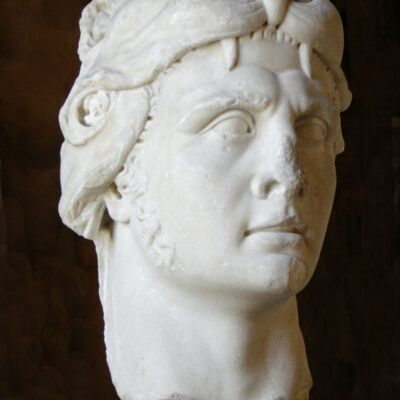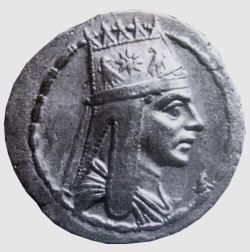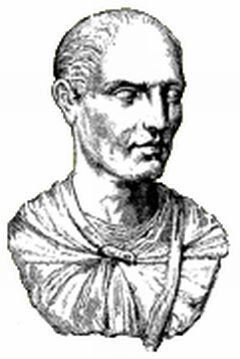Chapters
Rivalry between King Pontus Mithridates VI and Rome in the 1st century BCE it resulted from Pontus’ desire to create a regional power and supersede Roman influence.
Background of events
When Mithridates VI Eupator ascended the Pontic throne in 111 BCE, he managed to capture the vast coastal areas of the Bosphorus, touching some Greek cities. Pont wanted to expand his dominion in Asia Minor in the Black Sea basin, and thus conquer the Bosphorus and Hellespont, thus violating the fundamental interests of Rome. The rapid expansion and the related economic boom of Pontus significantly worried the Roman Senate. As early as 92 BCE Lucius Cornelius Sulla was sent east to support the allied kingdoms of Cappadocia, Paphlagonia and Bithynia, and which were in the sphere of interests of an ambitious ruler. Ultimately, after bilateral talks, an agreement was reached, and Mithridates promised his neutrality towards the Roman allies.
First Roman Pontic War
With the outbreak of the the Italic Rebellion in 90 BCE in the Apennine Peninsula, Mithridates saw his opportunity to use Rome’s involvement in another region. The King of Pontus had significant forces, which some sources describe as 300,000 men, 130 machines of war, and 300 ships(these are certainly exaggerated numbers). What is certain is that his army was powerful and with its help he returned to expansionist politics. He was additionally supported by the forces of his son-in-law, king of Armenia Tigranes.
Mithridates invaded Cappadocia and Bithynia, and from afar supported the insurgent Italics and the activities of pirates on the seas. Mithridates’ repeated attempts to subjugate Galatia and Pamphylia (91 BCE or 90 BCE) resulted in a Roman contract – in 89 BCE he was forced by the Roman legate Aquilius to withdraw from previously occupied territories, after which he was attacked in 88 BCE, at the instigation of Aquilius, by King Bithynia, Nicomedes IV Philopator, his former ally, and then by Aquilius himself, which gave rise to the so-called The First War with Mithridates (89-85 BCE).
The defeat of Aquilius opened the way for Mithridates to the Roman province of Asia; the king of Pontus took it over in a swift campaign, greeted enthusiastically by the inhabitants of most of the Greek cities there. Only some cities resisted. She was faithful to Rome, among others the island of Rhodes, which managed to defend itself despite a heavy siege.
After entering the province of Asia, Mithridates issued in Ephesus an edict ordering the Ephesians within 30 days to murder all immigrants from Italy without exceptions, men, women and children, free people and liberated people of Italian origin. The victims of the slaughter (the so-called Ephesian Vespers) fell then 80,000 (according to other sources up to 150,000) Romans and Italians who settled there1.
When the appointed day came calamities of various kinds befell the province of Asia, among which were the following: The Ephesians tore fugitives, who had taken refuge in the temple of Artemis, from the very images of the goddess and slew them. The Pergameans shot with arrows those who had fled to the temple of Aesculapius, while they were still clinging to his statues. The Adramytteans followed those who sought to escape by swimming, into the sea, and killed them and drowned their children. The Caunii, who had been made subject to Rhodes after the war against Antiochus and had been lately liberated by the Romans, pursued the Italians who had taken refuge about the Vesta statue of the senate house, tore them from the shrine, killed children before their mothers’ eyes, and then killed the mothers themselves and their husbands after them. The citizens of Tralles, in order to avoid the appearance of blood-guiltiness, hired a savage monster named Theophilus, of Paphlagonia, to do the work. He conducted the victims to the temple of Concord, and there murdered them, chopping off the hands of some who were embracing the sacred images.
– Appian of Alexandria, The Mithridatic Wars, 23.88 – 91
Inspired by the king, the slaughter was aimed at making the Greek allies more bound to each other. This purpose was also served by the exemption of Greek cities in Asia for 5 years from all taxes. The revolt against Rome had matured in the cities of Asia earlier. The population was reluctant to Roman authorities, which levied heavy taxes and exploited them.
It is worth adding that the state of Mithridates was strongly Hellenizing: Greek was used, coins in the Greek style were minted, and independent Greek communities were financially supported. In this way, Mithridates managed to win the support of Greek cities and the peoples of Asia Minor, who were reluctant to see Roman authority. The Mithridates plan provided for extensive military cooperation between the Pontines and the Greeks, which was to significantly increase the effectiveness and efficiency of the army. The Greeks, in turn, saw in Mithridates the next Alexander the Great, who realized some forms of cooperation between the Hellenistic states of high intellectual and technological development, and the military forces of Pontus. In Asia, it was believed that Mithridates’ plans went as far as Alexander of Macedon and that they themselves would take part in building another great empire. The biggest surprise was certainly the information about gaining the trust of Athens, a city that the Romans strongly favoured and whose loyalty they counted on. Mithridates referred in his propaganda mainly to the lowest social classes (as opposed to the Romans, who supported the local elite). The effective policy of King Pontus allowed him to gain the trust of the people of Asia, who, at his call, led numerous persecutions. The Romans could not remain indifferent to this turn of events.
Sulla upon hearing of the unexpected rebellion in Asia and the aggressive policy of Mithridates, he decided to turn back east. He did it despite the uninteresting political situation in the capital, where the populations tried to remove him from power, and imperium in the region was handed over to Gaius Marius. Despite the odds, he travelled to Greece in 87 BCE, where he calmed down. Then, despite the lack of support from Rome, which was already dominated by popular people, he began in pain to gather adequate resources and people for an expedition against the king of Pontus. As soon as he had the appropriate troops, he joined the siege of Athens, which he captured and brutally plundered (it was an example of his brutal policy) in 86 BCE. Then, with an army of 15,000, he beat under Cheronea 60,000 troops of Mithridates – Archelaos, despite the fact that he was deprived of supplies (the enemy fleet effectively blocked supplies). At that time, supporters of the agreement with Rome began to emerge in numerous Greek cities. In response, Mithridates began ruthlessly persecuting his opponents.
Another defeat was caused by Sulla to the Pontines in the two-day battle outside the city of Orchomenos in Boeotia. During this battle, at a critical moment, Sulla himself threw himself into the fray. The Senate, dominated by Sulla’s opposition, as a backup sent a Roman army to Asia under the command of Valerius Flaccus, after whose death the legate Gaius Flavius Fimbria took over. This one also crashed the Pontic army on the River Ryndacos and besieged Mithridates in Pergamon.
Mithridates, in a tragic situation, had to seek an agreement with Rome. Sulla, in turn, not wanting to let an almost certain victory fall to his rival, and at the same time wanting to restore a favourable political situation in Rome, as his opponents had come to the fore, offering Mithridates the peace that was concluded in the summer of 85 BCE in Dardanos. Under the treaty, Pont was to take over the lands originally owned by the kingdom, pay 3,000 talents in compensation, and hand over to the winner his Aegean fleet of about 80 ships at the time. Sulla abandoned the measures imposed in Asia by Mithridates but demanded that the taxes unpaid in the last five years, or some 20,000 talents, be repaid. To this end, all taxpayers had to borrow from collectors at a high percentage.
After settling the situation in Asia, Sulla came ashore at Brindisi in 83 BCE, along with huge gains from sanctuaries in Asia and Greece, and works of art and books. At the head of five legions, he set off for Rome to “pacify” the popular and restore power to the optimists.
Second Roman Pontic War
The peace at Dardanos was in fact an oral treaty between Mithridates and Sulla, nor was it ratified by the senate and violated as early as 83 BCE. legions to Pontus and Cappadocia. The Adventurous Expedition, known as the Second War with Mithridates, ended in 82 BCE with the defeat of the Romans.
Third Roman Pontic War
For a long time, Mithridates did not take any concrete steps to restore the status of a regional power for Pontus. It was only in 74 BCE that he once again turned his weapons against Rome. For the imminent next conflict with Rome, Mithridates prepared himself carefully: he expanded his army (if you believe the ancient authors – over 300,000 people) and formed numerous alliances, incl. with Sertorius, who survived the defeat of Marius’ supporters in Spain and with pirates marauding in the Mediterranean Sea.
The third war broke out in 74 BCE when Bithynia’s last king, Nikomedes Philopator bequeathed his state to Rome. Mithridates then spoke up for the disinherited son of Nicomedes. After declaring the war, Mithridates sent one of his armies to Cappadocia, the other to Phrygia, and himself with a basic force of about 120,000 people, went west along the shores of the Black Sea, easily taking Paphlagonia and Bithynia. This army was supported by a fleet of about 400 ships sailing along the coast, commanded by Aristonikos. Then Mithridates took up the siege of the city of Cyzicus. The persistent defence of the city gave the Romans time to organize a relief brought by the 35,000 troops of Lucullus (he served as a consulate with Aurelius Kotta), who forced Mithridates’ army to retreat in the winter of 74/73 BCE; at the same time the Roman fleet – recently defeated at Chalcedon – this time was victorious at the Battle of Lemnos. In the fall of 73 BCE Lucullus went on the offensive in Bithynia, and in 72/71 BCE attacked the indigenous territory of Pontus. In the Battle of Kabeira, Mithridates was completely defeated and had to save himself by fleeing to Armenia, managed by his son-in-law Tigranes. Meanwhile, the troops of Lucullus seized the entire Pont, along with the fortresses at Amasei, Synopia, and Amisos. In 69 BCE he attacked Pontus’ ally – Armenia. During the siege of the capital, during the Battle of Tigranocerta, he defeated the Armenian king Tigranes II. Lucullus forced two kings to flee and collected a huge spoil of war. He also travelled further towards the Caucasus to capture the ancient capital of Artaxata. Ultimately, however, his soldiers revolted and forced him to return. To make matters worse, tax collectors in Asia began to cause trouble for Lucullus after lowering taxes. In time, the senate lobbied by the collectors dismissed Lucullus from his post.
The situation was taken advantage of by Mithridates, who (with the help of Tigranes the Great) regained his kingdom in 67 BCE, and Tigranes took Cappadocia. Rome, fearing the revival of Mithridates’ power, decided to entrust the command in the East to an important person. The most famous commander at the time was Pompey the Great. Despite the great resistance of the senatorial aristocracy, he was entrusted with unusually large powers. In his hands, Pompey held: power over the naval forces and command of the field army of Asia with the right to declare war and conclude peace at his own discretion (of course, with the reservation that he would care for the public interest).
Pompey, with a lot of power, began his campaign in Cilicia, where he also gathered 60,000 legionaries and defeated Mithridates’ army in the upper reaches of the Euphrates. The King of Pontus did not receive the promised support of Tigranes, and, fearing an attack by the Parthians with whom Pompey had talked, withdrew to Colchis, and from there, after crossing the Caucasus, he went to the Cimmerian Bosphorus (present-day Crimea). In Crimea, after the condemnation of Machares, one of his sons, who had gone over to Rome in 70 BCE, Mithridates began vigorous preparations for further war. Being completely safe, he deluded that he would be able to gather the necessary army among the Thracians, Scythians, Getae and set out to conquer Italy. His plan was to march up the Danube, join the Gauls and a joint attack through northern Italy on Rome, and also an attack on Rome’s Balkan possessions from the north, from the Danube. Ruthless tax exploitation and cruel rule, however, led to the rebellion of the royal subjects. It was headed by Mithridates’ son, Pharnakes. Mithridates, trapped in the Bosporan capital of Pantikapayon, wanted to commit suicide. Due to the fact that for years he had taken small doses of various poisons in order to immunize and protect himself against a possible attack, the poison did not work. At the behest of Mithridates, a Gallic slave from the bodyguard on his command pierced him with a sword of the year 63 BCE:
I have profited much from your right arm against my enemies. I shall profit from it most of all if you will kill me, and save from the danger of being led in a Roman triumph one who has been an autocrat so many years, and the ruler of so great a kingdom, but who is now unable to die by poison because, like a fool, he has fortified himself against the poison of others. Although I have kept watch and ward against all the poisons that one takes with his food, I have not provided against that domestic poison, always the most dangerous to kings, the treachery of army, children, and friends.
– Appian of Alexandria, The Mithridatic Wars 111.538 – 540
Mithridates’ body was sent back, after embalming, by Pharnakes to Pompey as a sign of goodwill and friendship. Pompey ordered them to be burned with honours.
After the victory, Pompey pursued the Pontic king as far as Colchis, from where he decided to go to the Caspian Sea in order to probably start new trade routes with the Far East or compete with the eastern achievements of Lucullus. The march of Pompey and his subordinates, however, was stopped by diseases and fears of soldiers against monsters supposed to live in the far eastern lands (mainly large snakes were feared). Only the likeness of Mithridates, made of solid gold and measuring 3.5 m in height, took part in the triumph in Rome, which Pompey made in Rome. The statue was followed by some of the many children of the defeated ruler.
Consequences
Mithridates was one of Rome’s most formidable enemies in the East. He was close to creating a power that would unify within its borders the lands of the Black Sea basin. He became a cult figure for many artists. Ancient sources attribute to him almost superhuman qualities. He usually spoke Greek (in the so-called koine language), but he was also a polyglot – he supposedly knew 21 other languages from various neighbouring peoples. Carefully educated, in love with Greek literature and art, he maintained numerous contacts with eminent representatives of Hellenistic culture, looked after science and art (he wrote natural studies), was an energetic, brave leader, and brilliant politician, for which he was admired already in ancient times. He was extremely proficient in weapons, combat and hunting. He was characterized by great energy and entrepreneurship, as well as stubbornness and persistence in pursuing the set goals. He did not choose the means at the same time. He was famous for his wild cruelty not only towards his enemies but also towards his own family. At his order, his own mother, a sister who was also his first wife, three own sons and as many daughters were killed. Sentencing to elaborate death, gouging out eyes, cutting off hands, poison, etc. are the means of combating opponents and reluctant, often completely random people.
Pompey, after his victory, made a return journey through the Greek cities in the glory of a victor and a great leader who was looked at as a god. He gave the throne of Armenia to Tigranes to oppose it to the Parthians, proclaimed the fall of the Seleucids, and Syria was granted provincial status when Pont was incorporated into Bithynia. In addition, numerous buffer states were created: Galatia, Cappadocia, Cimmerian Bosphorus, Colchis. Pompey managed to stabilize the situation in the east for a while, which was to become the arena of rivalry between Rome and the Parthia.










